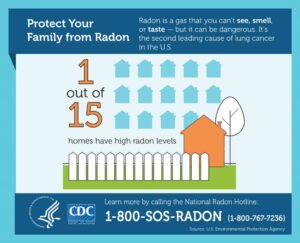January is National Radon Action Month. You may be wondering why this is on a smokefree housing website. Radon is the second leading cause of lung cancer, behind smoking. It’s the leading cause of lung cancer for nonsmokers. For people who smoke, radon exposure increases the risk of lung cancer even more than just smoking alone. The risk of lung cancer from radon exposure is estimated between 10 to 20 times greater for those who smoke cigarettes than those who have never smoked.1


So, what is radon?2
Radon is a naturally occurring colorless, odorless gas. It can reside at dangerous levels inside of homes, schools, and other buildings. It can enter a home through cracks in walls, basement floors, foundations, and other openings. As radon decays, it releases radioactive byproducts that are inhaled and can cause lung cancer. Because radon comes from rock and soil, it can be found anywhere.
What can you do about radon?2
Every home should be tested for radon. According to the Centers for Disease Control and Prevention, about 1 out of 15 homes have high radon levels. Radon has been found at high levels in every state. Keep in mind, your home can have elevated levels of radon while your neighbor’s home does not.
Testing is the only way to determine if you have a problem. There are two types of tests available. Short-term tests take about two-seven days. Long-term tests, which tend to be more accurate as they collect more data, take at least three months. Short term tests can help determine if there’s an issue in your home and requires follow-up testing. You can order a short or long term test kit at the American Lung Association.
If you prefer, you can hire a certified radon-testing professional. The best way to find a certified professional is to contact your state radon program. The EPA has a list of state contacts. You can also work with the state contact to find mitigation professionals if your home should have high radon levels.


Action Steps for Addressing Radon2
The EPA recommends taking action to reduce radon if you have a test result of 4.0 picocuries per liter of air. They also recommend considering similar actions when levels are between 2 and 4.0 picocuries per liter of air.
If you have an existing home with elevated levels of radon, you can fix the problem by having a radon mitigation system installed. If you are building a new home, ask your contractor to install radon-resistant features. You can get more detailed information from the EPA’s Consumer’s Guide to Radon Reduction. You can also find radon zones for Alaska at this site. But keep in mind, every home should be tested regardless of what zone you live in.
For more info, feel free to explore these resources:
- Real estate professionals can join the American Lung Association for a free one-hour webinar on radon. It will be on January 19th, 2022 at 11 AM Alaska Time. Register here.
- The Alaska Division of Geological and Geophysical Surveys has some local information, like a database on radon levels around the state. They invite Alaskan to contribute to it.
- They will also be hosting a Radon Test Kit Give-a-Way for National Radon Action Month.
- Being in Alaska can mean earthquakes. Check this resource out to see how earthquakes can impact radon.
- Check out the Centers for Disease Control and Prevention for other information, like drinking water from groundwater sources and other resources.
- Quitting smoking can help reduce your risk of lung cancer. If you’re ready to quit, you can
- Call the Alaska State Quitline at 1-800-QUITNOW
- Check out the American Lung Association’s cessation resources
- Talk with your doctor
References



